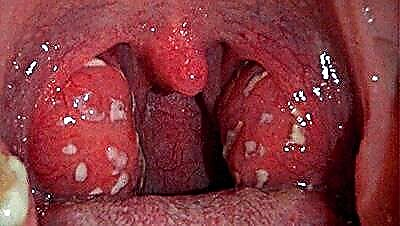The lymphoid tissue, from which the tonsils are formed, is involved in the production of immune cells, in hematopoiesis. The tonsils are a barrier to the entry of infection into the body. They are the first to take the blow when the body is attacked by pathogenic microflora. It is not surprising that many people often suffer from inflammation of the tonsils. This inflammation is called tonsillitis or tonsillitis. The question often arises: how is angina different from tonsillitis? Is it the same disease or is there a difference between them? Angina and tonsillitis are one disease. There is a difference between the forms of pathology.
Classification
- In the course of the process, tonsillitis happens:

- spicy;
- chronic.
- By localization:
- one-sided - one amygdala is affected;
- bilateral - both tonsils are affected.
- By form:
- primary form - lymphoid tissue is affected;
- the secondary form - inflammation of the tonsils develops against the background of acute infections of the nasopharynx and against the background of systemic blood pathologies.
- By types:
- catarrhal sore throat - the most common type, proceeds more easily than the others, spreads by airborne droplets;
- lacunar - spreads both by aerogenic and by contact;
- follicular - characterized by a severe course, purulent plaque on the tonsils;
- herpetic - caused by the Kosaki virus mainly in the warm season, in contrast to other species, which peak in the autumn-winter period;
- fibrinous - characterized by the presence of purulent plaque not only on the tonsils, but also on the entire surface of the oral mucosa. It occurs mainly as a complication of lacunar and follicular tonsillitis;
- phlegmonous (paratonsillitis, intratonsillar abscess) is a serious complication of other types of the disease. In people over 40 years of age, this species develops extremely rarely.
Certain (atypical) types of acute tonsillitis:
- ulcerative-membranous (ulcerative-necrotic) form - is rare, mainly in HIV-infected people, in people with a large lack of vitamins of group B, C. The causative agent is a symbiosis of microorganisms: spirochetes and fusiform sticks;
- laryngeal (submucous laryngitis) - the laryngeal ventricles, lymph nodes on the surface of the larynx are affected. The cause of this type can be not only pathogenic microflora, but also burns and trauma to the throat;
- syphilitic - long-term sluggish manifestation of syphilis, difficult to treat;
- fungal - caused by Candida;
- monocytic (infectious mononucleosis) - caused by a lymphotropic virus, which can spread not only by airborne droplets, but also intrauterinely from mother to fetus, as well as through blood during transfusion;
- agranulocytic - a rare manifestation of agranulocytosis.
All of these types refer to the acute course of angina.

The acute form of the disease is characterized by a sharp onset, a rapid increase in symptoms, severe intoxication, excessive weakness, plaque on the tonsils, severe sore throat, aching throughout the body, high fever that is difficult to bring down.
Chronic tonsillitis
Angina and tonsillitis are one disease characterized by a different course. Chronic tonsillitis is a complication of acute, characterized by frequent recurrence of the acute form (two to four times a year), alternating exacerbation and remission.
An exacerbation of a chronic process is called a sore throat.
In addition to the acute form, the cause of the transition of the disease to the chronic form can be problems with the nasal septum, polyps in the nose, purulent sinusitis, adenoid hypertrophy in children, adenoiditis.
Classification
- The form of chronic tonsillitis is:
- simple form - characterized by local manifestations;
- toxic-allergic form - characterized not only by local manifestations, but also by intoxication.
- By stages:
- compensated stage - characterized by the absence of visible clinical manifestations. In the tonsils there is a permanent passive infectious focus, but the function of the glands is not impaired;
- decompensated stage - characterized by an active inflammatory process, persistent sore throats, inflammation of the ENT organs, and the frequent development of complications.
- Signs of exacerbation:

- moderate to severe sore throat is persistent;
- painful sensations in the tonsils;
- caseous plugs that extend beyond the palatine tonsils, which cause bad breath;
- constant feeling of a lump in the throat;
- swelling and pain in the lymph nodes;
- constant temperature fluctuations from normal to subfebrile. Subfebrile temperature persists for a long time;
- recurrent pain in individual joints;
- decreased performance, fatigue.
Treatment
In chronic tonsillitis, conservative treatment is resorted to in the stage of compensation and in the stage of decompensation if there are contraindications to surgery. Conservative therapy includes anti-inflammatory drugs, drugs for relieving symptoms, local antiseptics, sparing food, drinking plenty of fluids, gargling. Many experts believe that the best treatment is the surgical removal of the tonsils - tonsillectomy.
Differences between tonsillitis and tonsillitis
Let's talk about the difference between tonsillitis and tonsillitis. There is practically no difference in etiology between acute and chronic tonsillitis. The causative agents of both forms can be bacteria, viruses, fungi, bacilli, which are activated under the influence of unfavorable factors.
The most common causative agent of the disease is group A streptococcus. Throat trauma, burns of the mucous throat, inflammation of the nasopharynx can also be the cause of the disease with weakened immunity.
- Both types of the disease differ from each other in the severity of symptoms. If in a chronic course the symptoms are smoothed out, weakly expressed, then in an acute course the clinical picture is bright, the symptoms grow rapidly, the development is rapid, and severe intoxication phenomena are observed.
- In a chronic course, catarrhal phenomena, nasal congestion are more pronounced, which is extremely rare in acute course. With angina, purulent plugs form in the tonsils, with chronic tonsillitis - caseous.
- There are also differences in treatment. In the acute phase, antibiotic therapy is required, bed rest is prescribed. In a chronic course, bed rest and antibiotics are not needed, except that antibiotic sprays are used for the throat. Otherwise, the therapeutic measures are similar: symptomatic therapy, vitamins, diet, drinking plenty of fluids, gargling.
- Acute tonsillitis differs from chronic tonsillitis by a high risk of developing complications that threaten the patient's life. With a sluggish process, severe complications also develop (rheumatism, glomerulonephritis), but with timely treatment, these conditions do not lead to death. After a sore throat, blood poisoning, brain abscess, myocarditis, and laryngeal edema may develop. These dangerous diseases end in the death of the patient, if urgent measures are not taken.
Prevention in both cases is the same: strengthening the immune system, avoiding hypothermia, good nutrition, vitamin therapy courses, timely treatment of infectious diseases of the nasopharynx and chronic pathologies.





